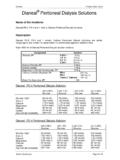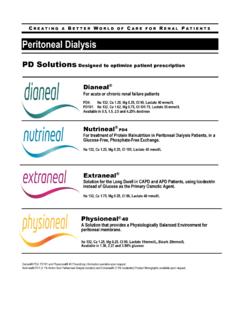Transcription of DIANEAL Peritoneal Dialysis Solution - …
1 DIANEAL Peritoneal Dialysis SolutionFor intraperitoneal administration only07-19-68-315-1- DIANEAL PD-2 Peritoneal Dialysis Solution With Dextrose DIANEAL PD-2 Peritoneal Dialysis Solution With Dextrose DIANEAL PD-2 Peritoneal Dialysis Solution With Dextrose DIANEAL Low Calcium ( mEq/L) Peritoneal Dialysis Solution With Dextrose DIANEAL Low Calcium ( mEq/L) Peritoneal Dialysis Solution With Dextrose DIANEAL Low Calcium ( mEq/L) Peritoneal Dialysis Solution With DextroseDESCRIPTIONDIANEAL Peritoneal Dialysis Solutions are sterile, nonpyrogenic solutions in AMBU-FLEX and ULTRABAG containers for intraperitoneal administration only. The Peritoneal Dialysis solutions contain no bacteriostatic or antimicrobial , calculated osmolarity, pH, and ionic concentrations are shown in Tables 1-4. DIANEAL is a hyperosmolar plastic container is fabricated from polyvinyl chloride (PL 146 Plastic).
2 Exposure to temperatures above 25 C/77 F during transport and storage will lead to minor losses in moisture content. Higher temperatures lead to greater losses. It is unlikely that these minor losses will lead to clinically significant changes within the expiration period. The amount of water that can permeate from inside the Solution container into the overwrap is insufficient to affect the Solution in contact with the plastic container can leach out certain of its chemical components in very small amounts within the expiration period, di-2-ethylhexyl phthalate (DEHP), up to 5 parts per million; however, the safety of the plastic has been confirmed in tests in animals according to USP biological tests for plastic containers as well as by cell culture toxicity PHARMACOLOGYM echanism of ActionDIANEAL is a hypertonic Peritoneal Dialysis Solution containing dextrose, a monosaccharide, as the primary osmotic agent.
3 An osmotic gradient must be created between the Peritoneal membrane and the Dialysis Solution in order for ultrafiltration to occur. The hypertonic concentration of glucose in DIANEAL exerts an osmotic pressure across the Peritoneal membrane resulting in transcapillary ultrafiltration. Like other Peritoneal Dialysis solutions, DIANEAL contains electrolytes to facilitate the correction of electrolyte abnormalities. DIANEAL contains a buffer, lactate, to help normalize acid-base of DIANEALG lucose content in DIANEAL is expressed as dextrose monohydrate and is available in three concentrations: , and is rapidly absorbed from the Peritoneal cavity by diffusion and appears quickly in the circulation due to the high glucose concentration gradient between DIANEAL compared to blood capillary glucose level. Absorption per unit time will be the highest at the start of an exchange and decreases over time. The rate of glucose absorption will be dependent upon the transport characteristics of the patient s Peritoneal membrane as determined by a Peritoneal equilibration test (PET).
4 Glucose absorption will also depend upon the concentration of glucose used for the exchange and the length of the dwell. Glucose is metabolized by normal cellular pathways ( glycolysis) and provides a source of calories and may elevate blood glucose of other molecules across the Peritoneal membrane, such as lactate, will occur by diffusion. Metabolism of lactate occurs in the liver and results in the generation of the bicarbonate. Transport of other molecules will be dependent upon the molecular size of the solute, the concentration gradient, and the effective Peritoneal surface area as determined by the AND USAGEDIANEAL Peritoneal Dialysis solutions are indicated for patients in acute or chronic renal failure when nondialytic medical therapy is judged to be is contraindicated in patients with pre-existing severe lactic Peritoneal Sclerosis (EPS) is considered to be a known, rare complication of Peritoneal Dialysis therapy.
5 EPS has been reported in patients using Peritoneal Dialysis solutions including DIANEAL . Infrequently, fatal outcomes of EPS have been reported with with severe lactic acidosis should not be treated with lactate-based Peritoneal Dialysis solutions (See Contraindications). Patients with conditions known to increase the risk of lactic acidosis [ , acute renal failure, hepatic failure, inborn errors of metabolism, treatment with drugs such as metformin, nucleoside/nucleotide reverse transcriptase inhibitors (NRTIs), and sepsis/shock] must be monitored for the occurrence of lactic acidosis before the start of treatment and during treatment with lactate-based Peritoneal Dialysis prescribing the Solution to be used for an individual patient, consideration should be given to the potential interaction between the Dialysis treatment and therapy directed at other existing illnesses. Serum potassium levels should be monitored carefully in patients treated with cardiac glycosides.
6 For example, rapid potassium removal may create arrhythmias in cardiac patients using digitalis or similar drugs; digitalis toxicity may be masked by hyperkalemia, hypermagnesemia, or hypocalcemia. Correction of electrolytes by Dialysis may precipitate signs and symptoms of digitalis excess. Conversely, toxicity may occur at suboptimal dosages of digitalis if potassium is low or calcium is require careful monitoring of insulin requirements and other treatments for hyperglycemia during and following Dialysis with dextrose containing RelatedDIANEAL is intended for intraperitoneal administration only. Not for intravenous following conditions may predispose to adverse reactions to Peritoneal Dialysis procedures: abdominal conditions, including uncorrectable mechanical defects that prevent effective Peritoneal Dialysis or increase the risk of infection, disruption of the Peritoneal membrane and diaphragm by surgery, congenital anomalies or trauma prior to complete healing, abdominal tumors, abdominal wall infections, hernias, fecal fistula, colostomies or ileostomies, frequent episodes of diverticulitis, inflammatory or ischemic bowel disease, large polycystic kidneys, or other conditions that compromise the integrity of the abdominal wall, abdominal surface, or intra-abdominal cavity, such as documented loss of Peritoneal function or extensive adhesions that compromise Peritoneal function.
7 Conditions that preclude normal nutrition, impaired respiratory function, recent aortic graft placement, and potassium deficiency may also predispose to complications of Peritoneal APPROVAL / RELEASED ARTWORKC heck as applicablePrinted NameSignature Date Excluding dimensions Excluding bar code dimensions English Other Language:_____Printed NameSignature Date Excluding dimensions Excluding bar code dimensions English Other Language:_____BAXTER CONFIDENTIALINTERNAL USE ONLYD ocument No.: 07-19-68-315 Change No.: CP0595601 Page 1 of 6P1 25-JUL-2013 JMC-2-Aseptic technique must be employed throughout the Peritoneal Dialysis procedure to reduce the possibility of use, the drained fluid should be inspected for the presence of fibrin or cloudiness, which may indicate the presence of peritonitis occurs, the choice and dosage of antibiotics should be based upon the results of identification and sensitivity studies of the isolated organism(s) when possible.
8 Prior to identification of the involved organism(s), broad-spectrum antibiotics may be of Peritoneal Dialysis Solution volume into the Peritoneal cavity may be characterized by abdominal distention, feeling of fullness and/or shortness of breath. Treatment of overinfusion is to drain the Peritoneal Dialysis Solution from the Peritoneal for Trained PhysicianTreatment should be initiated and monitored under the supervision of a physician knowledgeable in the management of patients with renal patient s volume status should be carefully monitored to avoid hyper- or hypovolemia and potentially severe consequences including congestive heart failure, volume depletion and hypovolemic shock. An accurate fluid balance record must be kept and the patient s body weight monitored. Excessive use of DIANEAL Peritoneal Dialysis Solution with higher dextrose concentration during a Peritoneal Dialysis treatment may result in significant removal of water from the patient (see Dosage and Administration).
9 Significant losses of protein, amino acids, water-soluble vitamins and other medicines may occur during Peritoneal Dialysis . The patient s nutritional status should be monitored and replacement therapy should be provided as for PatientsPatients should be instructed not to use solutions if they are cloudy, discolored, contain visible particulate matter, or if they show evidence of leaking containers (see Dosage and Administration).Aseptic technique must be employed throughout the improper clamping sequence may result in infusion of air into the peritoneum (see Dosage and Administration, Directions for Use).To reduce possible discomfort during administration, patients should be instructed that solutions may be warmed to 37 C (98 F) prior to use. Only dry heat should be used. It is best to warm solutions within the overwrap using a heating pad. To avoid contamination, solutions should not be immersed in water for warming.
10 Do not use a microwave oven to warm the Solution (see Dosage and Administration, Directions for Use).Laboratory TestsSerum ElectrolytesDIANEAL does not contain potassium. Evaluate serum potassium prior to administering potassium chloride to the patient. In situations where there is a normal serum potassium level or hypokalemia, addition of potassium chloride (up to a concentration of 4 mEq/L) to the Solution may be necessary to prevent severe hypokalemia. This should be made under careful evaluation of serum and total body potassium, and only under the direction of a , hematology, blood chemistry, electrolyte concentrations, and bicarbonate should be monitored periodically. If serum magnesium levels are low, magnesium supplements may be receiving DIANEAL solutions should have their calcium levels monitored for the development of hypocalcemia or hypercalcemia. In these circumstances, adjustments to the dosage of the phosphate binders, vitamin D analogs, and/or calcimimetics should be considered by the physician.






